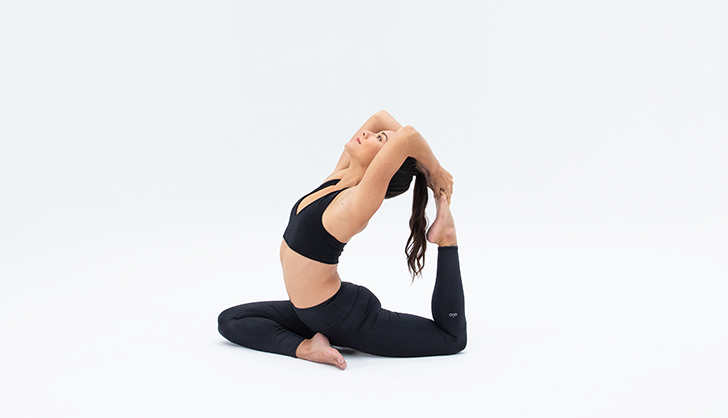Difficult yoga poses require great balance, flexibility and strength. They also improve your focus and are amazing to look at.
These advanced poses can be challenging for beginners, but they are incredibly rewarding when you achieve them. They are a fantastic way to tone your body and strengthen your core.
Tripod Headstand with Lotus Legs
This is a challenging pose and only suitable for experienced yoga students. It requires a lot of core strength to lift the legs and maintain balance in this position. It is also important to practice this pose with the guidance of a yoga teacher to ensure that you have correct alignment and posture. This will help you prevent injuries to the knees and hip joints.
To get into this position, you must first sit in Half Lotus Pose and then wiggle your right foot so that it slips in front of the left inner thigh. Then, snuggle the feet together and lower yourself into a tighter Lotus Pose. Keep the belly in and shoulders lifted to create a supportive foundation for the legs and head.
Once in the pose, you can move slowly up to a full headstand by walking your feet up toward the back of your head and keeping your hands on the floor. This pose also helps to stretch, strengthen and lengthen the shoulders, hips, hamstrings and quadriceps muscles as well as improve the neck and shoulder flexibility.
From the perspective of ayurvedic medicine, this posture activates the Nadis (the energy passages in the body). It has numerous healing properties and is considered to be an excellent cure for headaches, asthma and menstrual problems.
Side Plank
This balancing posture requires core and upper body strength as well as the ability to maintain one side of the body for an extended period of time. Beginners can ease into the pose by keeping their bottom knee on the floor, which will lessen the challenge for them as they build strength and stability. Once students are comfortable in the basic form, they can begin to experiment with variations that increase the challenge and help to strengthen their muscles.
To work up to the full version of this yoga pose, start with a plank and then shift your weight onto your right hand so that it rests on the outer edge of the left foot, stacking both feet. Stack your shoulders over the left wrist and spread the fingers of the right hand to distribute the weight evenly. Eventually, your students can move their gaze up toward the thumb of their right hand to find a steady point and then gradually lengthen the top arm toward the ceiling.
To make this pose even more challenging, you can add another variation from Tabletop Pose to the starting position. Begin with your right leg on the floor and then move it out to the side of your mat, positioning the foot so that it is in line with your shoulder. You can then lift the hips and extend the right arm to the sky as before, or you can bend the top knee and grasp the big toe with your first two fingers as in Camatkarasana (Wild Thing).
Corpse Pose
While it may look like a simple resting pose, Corpse Pose or Savasana is often the most difficult yoga pose for beginners. Lying still for several minutes can be challenging, especially if you’ve been working up a sweat through the other poses in class. The ability to relax isn’t something that comes naturally, and it takes practice to master.
This is the final yoga pose in every yoga sequence, and it’s designed to help you wind down after your workout. You can use this time to meditate and cultivate mindfulness or relax to a guided relaxation session. It’s an important part of the yoga practice because it gives your body and mind a chance to restore itself before beginning your day.
You can hold this final pose for as long as you want, but it’s recommended that you stay in the pose for about 20 minutes. If you’re struggling to relax in this position, try using a blanket or bolster under your legs to elevate them and make the pose more comfortable. Discomfort can distract you from achieving the peace that Corpse Pose is meant to provide, so it’s best to keep it as comfortable as possible.
This is a safe pose for most people, but pregnant women should avoid lying flat on their backs because it can compress the vein that returns blood to the heart. If you’re 7 to 9 months pregnant, place a rolled-up blanket or pillow behind your head and chest to help keep you upright.
Handstand Scorpion
Scorpion Pose, or Vrischikasana, is another awe-inspiring and challenging yoga posture for beginners. This pose combines backbends with hand balances and requires incredible strength and stability. It looks like a move straight out of Cirque du Soleil, and it’s definitely not for the faint of heart. This pose is a good way to challenge your balance and strengthen the shoulders, elbows, hips, and legs. It also helps to open the thoracic spine and improves lung capacity.
If you are new to yoga, it is best to practice this advanced pose with the help of a yoga teacher. This will help you understand your limits and prevent injury. It is also a good idea to practice forearm stand at the wall until you can comfortably do this pose without support. You should not perform this posture if you have any shoulder, back or wrist injury and should also avoid this pose if you are pregnant or have high blood pressure.
This pose can be a difficult one for beginners, but it has many benefits that are worth attempting. It improves your core strength, balance, and endurance while helping you to calm the mind. It can also help you to relax and feel rejuvenated after a long day at work or school. It is also a great way to improve your sleep patterns.










